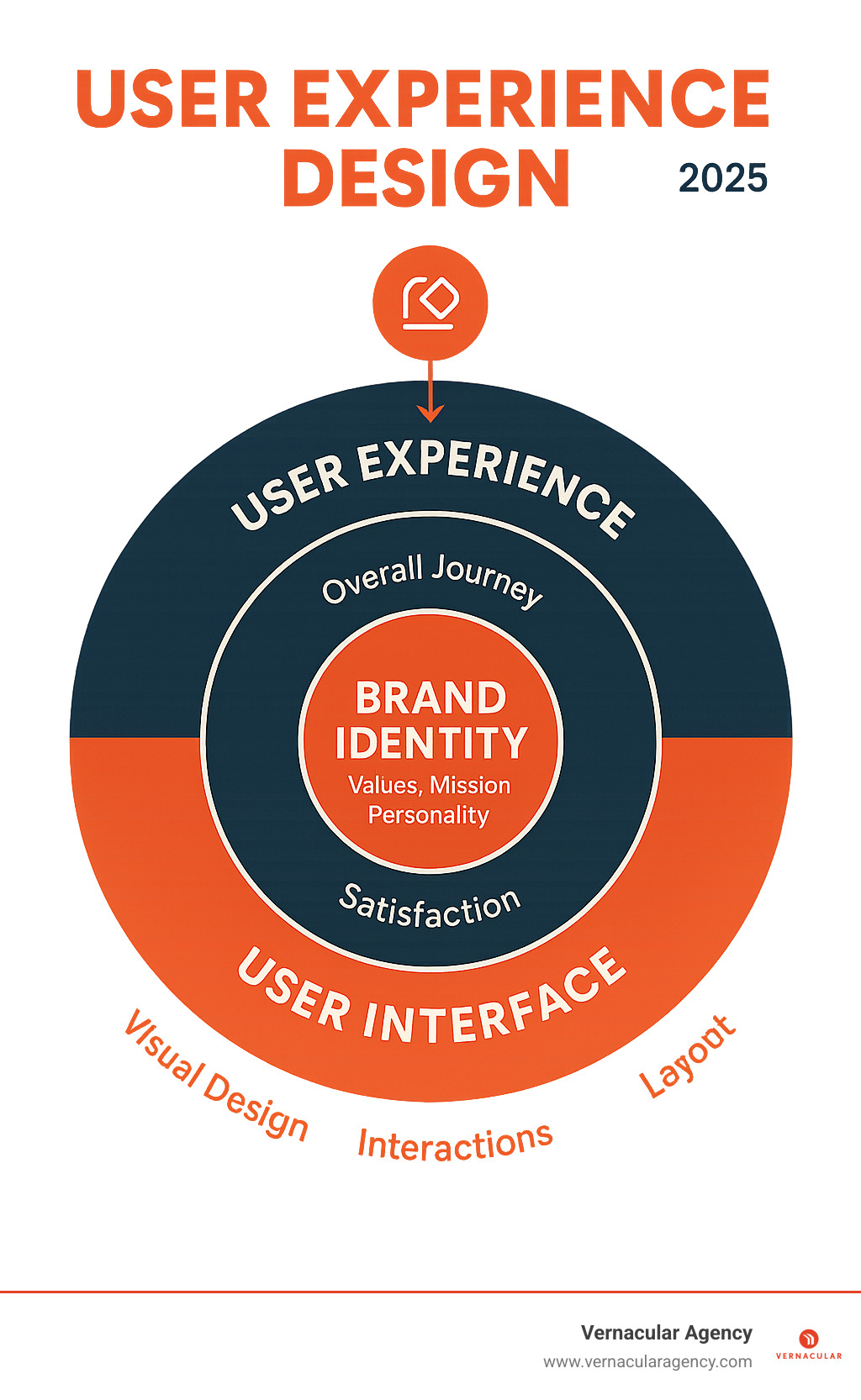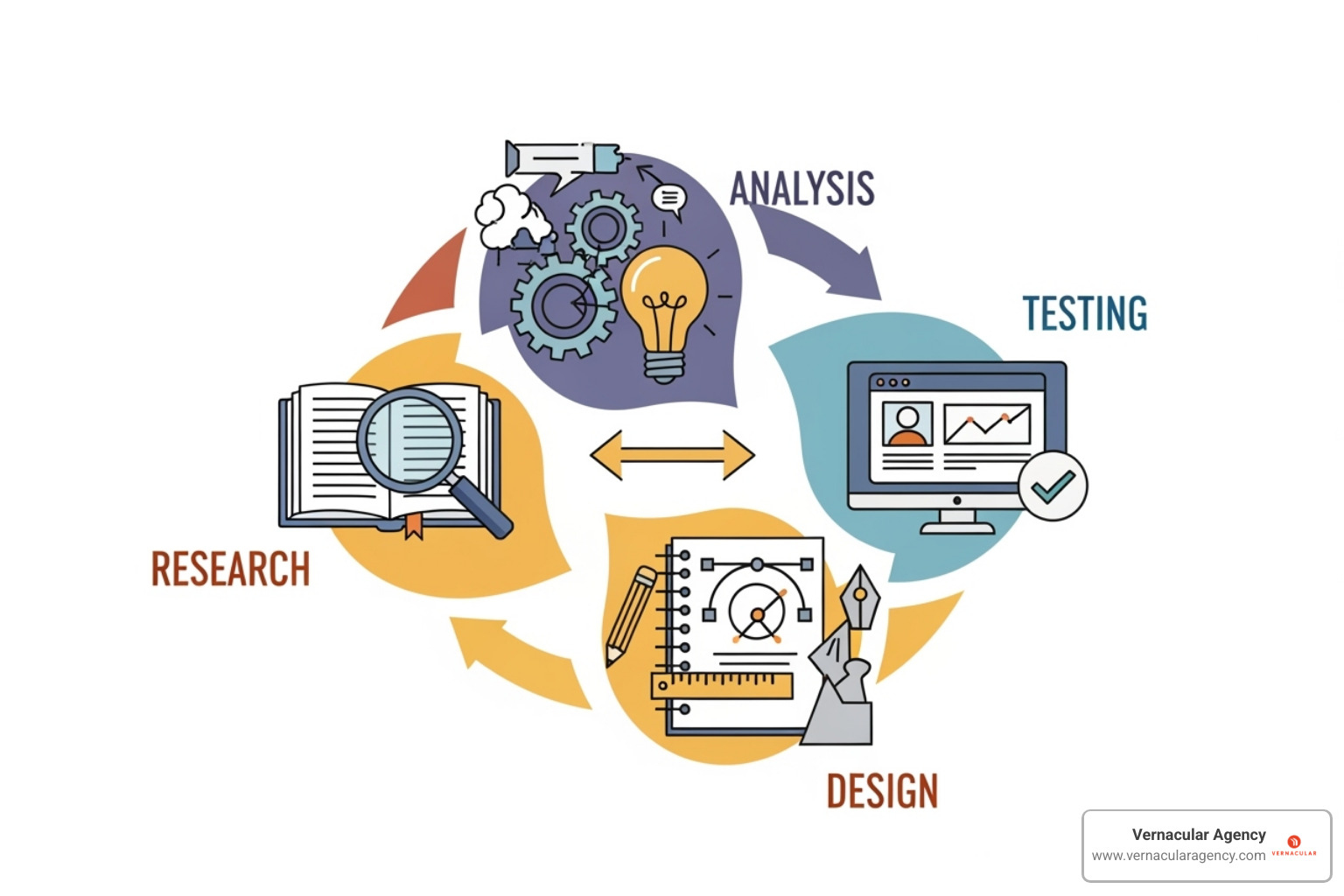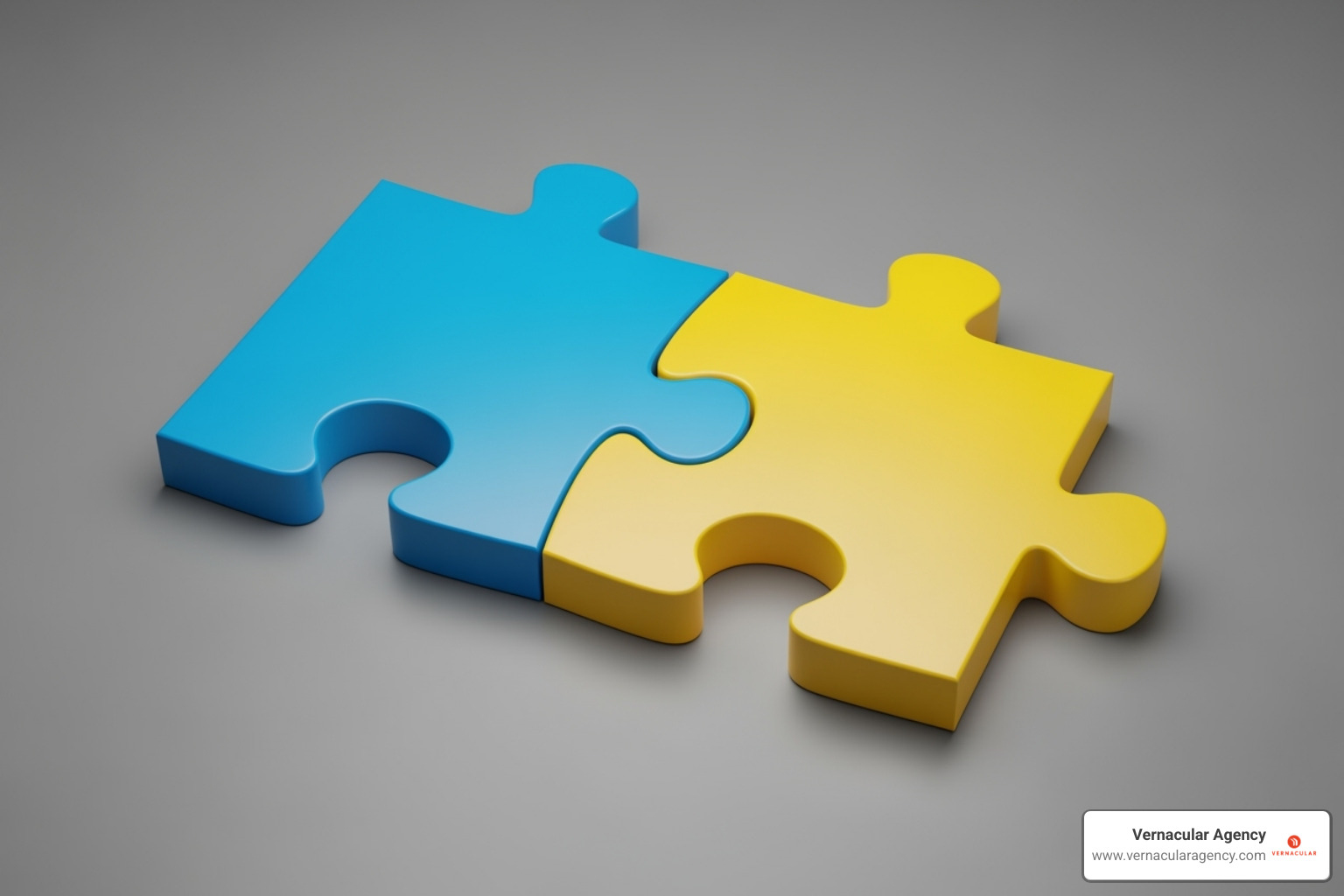User experience design is the process of creating products that provide meaningful and relevant experiences to users. It focuses on the entire journey a person takes when interacting with your company, product, or service—from their first impression to long-term loyalty.
Quick Answer: What is User Experience Design?
The field emerged in the 1990s when Don Norman coined the term "user experience" while working at Apple. As Norman explained, "User experience encompasses all aspects of the end-user's interaction with the company, its services, and its products."
Today, user experience design is critical for business success. Companies with strong UX see higher conversion rates and better customer retention. Understanding UX principles can transform how customers perceive and interact with your business.
I'm Rebecca Falzano, Creative Director with nearly 15 years of experience guiding content creation and design across shelter magazines in New York City and Maine. My collaborative approach to user experience design focuses on crafting narratives that resonate with clients while ensuring every touchpoint supports both user needs and business goals.

User experience design is the art and science of creating products and services that truly work for people. It's not just about making something look pretty—it's about understanding how people think, feel, and behave when they interact with your product.
When Don Norman coined the term "user experience" at Apple, he explained that it encompasses "all aspects of the end-user's interaction with the company, its services, and its products." This includes everything from brand findy to long-term product use.
Think about the last time you used an app that just worked. You probably didn't think about the design—you just accomplished what you needed to do. That seamless feeling? That's great user experience design at work.
The Nielsen Norman Group explains that user experience design considers the entire process of how people find, learn about, and use a product. It covers the whole relationship between people and products, not just a single interaction.
Great UX design creates solutions that people actually want to use—and keep using. We focus on making products that are usable (easy to learn and efficient), enjoyable (satisfying to interact with), equitable (accessible to people of all abilities), and useful (solving real problems that matter).
At its heart, user experience design is problem-solving. We identify user challenges and design solutions that make their lives easier, adapting technology to human needs rather than forcing people to adapt to confusing interfaces.
The best UX design serves everyone: users get a positive experience that helps them achieve their goals, and businesses see better results through increased satisfaction and loyalty. When your digital presence truly serves your audience's needs, everyone wins. That's exactly what we focus on with our web development services.
Here's where many people get confused: user experience isn't just about making things easy to use. Usability is important, but it's only one piece of the puzzle.
Imagine a door that opens perfectly fine but is painted an ugly color and placed in a weird spot. It's "usable," but the overall experience is still poor. That's the difference between usability and user experience design.
User experience design considers the bigger picture. It shapes brand perception—how people feel about your company based on every interaction they have with you. When someone visits your website, calls your office, or sees your social media posts, they're forming opinions about your brand.
It also builds customer loyalty. People return to products that make them feel good. When your user experience design creates positive emotions and genuine connections, customers become advocates who recommend you to others.
The best user experience design creates a holistic experience that feels consistent across all touchpoints. Sometimes we even achieve user delight—those moments when a product surprises you in a good way, like a clever animation or a helpful suggestion.
While usability focuses on whether something works, user experience design focuses on how it feels to use it. We're designing for both the practical and emotional sides of human nature.
Great user experience design doesn't happen by accident. It's built on solid principles and follows a thoughtful process that puts people first. Think of it like building a house – you need a strong foundation and a clear plan to create something that truly works for the people who'll live there.

At the heart of user experience design is design thinking—a flexible, problem-focused approach. It's an iterative process where we build, test, learn, and improve in cycles rather than expecting perfection on the first try.
This process thrives on collaboration between designers, developers, and stakeholders. We use user research to understand real needs, prototyping to test ideas, and continuous testing to stay on the right track.
Peter Morville's UX Honeycomb breaks down what makes experiences truly work for people. These seven principles guide every decision we make in user experience design.
A great experience needs to be useful – it should solve a real problem. It also needs to be usable, meaning people can figure out how to use it without confusion. The experience should feel desirable, creating an emotional connection through visual design and personality. It needs to be findable, with clear navigation so users don't get lost.
Accessibility ensures that people with different abilities can use the product effectively, which opens your product to a wider audience. The experience must be credible, building trust through reliable functionality. Finally, it should be valuable, delivering real benefit to both users and the business.
The user experience design process follows five key stages to move from a problem to a working solution.
We start by empathizing through research. This means getting to know the people we're designing for. We conduct interviews, observe behaviors, and create user personas and journey maps to understand their frustrations and goals.
Next, we define the core problems by analyzing our research. This stage is crucial because solving the wrong problem means even the best design will fail.
Then comes ideating, where we brainstorm solutions. This is a creative stage where we sketch, discuss, and explore different approaches, aiming for a high quantity of ideas to choose from.
In the prototype stage, we turn our best ideas into something tangible. We create wireframes and interactive prototypes that people can click through. These don't need to be perfect, just good enough to test our assumptions.
Finally, we test our prototypes with real users. We watch how they interact with our designs and listen to their feedback to identify what works. This testing phase often sends us back to earlier stages for refinement, which is the heart of an iterative process.
This cycle of research, design, and validation ensures our final product truly serves its users. You can see how we apply these principles in our work creating great architecture websites that showcase both form and function.
One of the most frequent questions in the design world is the difference between User Experience (UX) and User Interface (UI). Though often used interchangeably, they are distinct yet interdependent. Think of a car: UX is the overall driving experience—the comfort, control, and smoothness of the journey. UI is the dashboard's layout, the button design, and the look of the navigation screen.
Here’s a simple way we explain it:
To break it down further, let's look at a comparison:
| Feature | UX Design (The 'Why' and 'How') | UI Design (The 'What' and 'Look') |
|---|---|---|
| Goals | Solve user problems, improve usability, create meaningful journeys | Create aesthetically pleasing, interactive, and consistent interfaces |
| Process | Research, analysis, wireframing, prototyping, user testing | Visual design, graphic layout, typography, color palettes, interaction states |
| Deliverables | User flows, personas, wireframes, prototypes, usability reports | Visual mockups, design systems, interactive components, animations |
User Interface (UI) design is a crucial subset of user experience design focused on a product's visual and interactive elements. It's about making the digital space beautiful, intuitive, and engaging. As the Interaction Design Foundation explains, UI design is the process of making interfaces that are easy to use and a pleasure to look at.
When we dig into UI design, we're primarily concerned with:
While UX design maps out the user's journey, UI design brings that map to life with engaging visuals and seamless interaction points, ensuring the product is delightful to use.
UX and UI are two puzzle pieces; neither is effective without the other. User experience design lays the strategic blueprint, determining the structure and flow that best serves user needs.
Then, User Interface design steps in to bring that blueprint to life, turning wireframes from the UX phase into the visually appealing and interactive product users see. It's the art of making the interface beautiful, consistent, and easy to steer.

Together, UX and UI create a seamless experience. A brilliant UX ensures the product is useful, while an outstanding UI ensures it's beautiful. Without good UX, a product might look stunning but be frustrating. Without good UI, a product might be functional but appear uninviting. This collaboration is paramount for product success, following the principle of "form follows function." This synergy is vital when we're designing websites for clients, as seen in our website design for architects services.
User experience design isn't just about making things look nice; it's one of the smartest financial investments a business can make. When you invest in thoughtful UX design, you're investing in your bottom line.
A frustrating website experience leads to lost leads and abandoned carts. That's why UX design delivers a strong return on investment (ROI). When users can easily steer your site and complete tasks, they are far more likely to convert. Good UX design directly leads to increased conversions.
Great user experience design also drives customer retention. A positive brand experience creates loyalty, and retaining customers is far more cost-effective than acquiring new ones.
Perhaps most importantly, investing in UX design early saves money in the long run. By understanding user needs and testing ideas before full development, you avoid costly mistakes and achieve reduced development costs. It's much cheaper to fix a problem in the design phase than after you've built the entire system.
Your brand identity lives in every interaction someone has with your business. In our digital world, that means user experience design plays a huge role in shaping how people perceive your brand.
When someone visits your website and everything works perfectly, it communicates professionalism, reliability, and that you care about their experience. On the flip side, a poor digital experience can undermine brand trust before people even give your product a chance.
When users consistently have positive experiences with your digital touchpoints, it builds powerful user satisfaction. Happy users become advocates who share their positive experiences, creating organic word-of-mouth marketing that money can't buy.
In competitive markets, superior user experience design becomes a key market differentiation. It's what makes people choose you over someone else. At Vernacular Agency, we see this every day—brands with cohesive, thoughtful experiences stand out. That's why our brand identity services always consider the full user journey.
User experience design has the power to include or exclude people. There's no excuse for leaving anyone behind.
Accessibility in UX design means creating digital experiences that work for everyone, including people with visual, hearing, motor, or cognitive differences. This isn't just kind—it's often legally required and always makes good business sense.
When we design with accessibility in mind, we follow the Web Content Accessibility Guidelines (WCAG). These standards ensure that people using assistive technologies can use websites effectively. The guidelines focus on making content perceivable, operable, understandable, and robust.
True inclusivity goes even further, considering people from different cultural backgrounds and levels of digital comfort. When you design inclusively, you're not just checking a box—you're opening your doors to a wider audience reach and showing genuine social responsibility.
The beautiful thing about accessible design is that it often improves the experience for everyone. Captions help people in noisy environments, and clear navigation helps people in a hurry. By designing for all abilities, you create better experiences across the board.
This approach demonstrates that your brand values all people, which resonates strongly with today's consumers. For detailed information, check out the Web Content Accessibility Guidelines (WCAG) 2.0.
The field of user experience design is thriving. As businesses recognize that good UX impacts the bottom line, the high demand for skilled UX designers continues to grow. The profession boasts strong job growth and is often ranked as a top career choice.
The field blends creativity and logic, allowing designers to solve real-world problems. Career paths are diverse, spanning industries from healthcare to e-commerce. A strong portfolio is essential to showcase your problem-solving process, and the field requires continuous learning as technology and user behaviors evolve.

Becoming a great UX designer requires both the soft skills to connect with people and the hard skills to build solutions. The soft skills are what separate good designers from great ones.
Empathy sits at the heart of everything we do. You need to genuinely care about understanding what makes people tick, what frustrates them, and what delights them.
Communication is a critical skill. You must be able to explain why a design works to your team, stakeholders, and clients, translating user needs into business language.
Collaboration is where the magic happens. User experience design is never a solo act; you're constantly working with developers, product managers, and other designers.
On the technical side, user research forms the foundation. This means conducting interviews, running surveys, and analyzing data. Wireframing and prototyping are your tools for bringing ideas to life quickly for testing. Information architecture is about making sure people can find what they're looking for.
Every UX designer needs a digital toolbox. While you can start with pencil and paper, the right software makes collaboration smoother.
Figma has become a go-to choice for its real-time collaboration. Sketch remains popular among Mac users, while Adobe XD integrates with the Adobe ecosystem. InVision excels at creating interactive prototypes that feel like the real product.
For planning, Miro is like an infinite virtual whiteboard for brainstorming and mapping user journeys. To test designs with real users, platforms like UserTesting, Maze, or Lookback let you gather remote feedback.
What matters most isn't mastering every platform, but understanding how to use them to communicate your ideas and validate your assumptions.
The job outlook is strong. In the US, the UX designer salary for experienced designers can range from $90,000 to $128,000 or more. Beyond salary, the sheer variety of opportunities is compelling.
The job market has opened up roles that didn't exist a decade ago. You might become a UX researcher, uncovering user insights through interviews and testing. An interaction designer focuses on how users move through digital experiences. Product designers balance user needs with business goals, while information architects make sure websites make sense to steer.
The best part? This in-demand field spans every industry imaginable. Healthcare, finance, education, e-commerce—everyone needs good user experience design. You're making technology more human and more helpful, which is rewarding work.
The truth is simple: when you design for people, your business thrives. User experience design isn't a marketing checkbox; it's the foundation for success. At Vernacular Agency, we've seen how a genuine human-centered approach transforms brands.
Contrast a frustrating online experience with one that feels intuitive. That seamless feeling is the power of thoughtful user experience design.
Making strategic investments in UX leads to higher user satisfaction, which builds loyalty, improves conversions, and makes your brand stand out. It shows you genuinely care about the people you serve.
We believe every touchpoint matters—from your website's navigation to your brand colors. These elements must work together to create a cohesive experience that tells your story effectively.
Our approach combines the strategy of user experience design with strong branding and technical excellence. We're not just making things look pretty; we're creating digital experiences that connect with real people and drive real business results.
Ready to see what happens when you put people first? Your customers are waiting for experiences that truly serve them, and we're here to help you deliver exactly that. Learn more about our digital marketing services and let's create something that makes both your users and your bottom line happy.